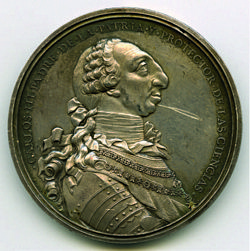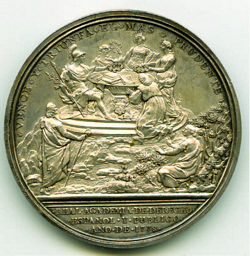A rare and important Mexican Colonial medal
by Carlos Jara


Of great historical importance to collectors of Mexican Colonial medals is the series of commemorative medals struck in Mexico for the Royal Academy of Spanish and Common Law and catalogued in GroveGrove, Frank, Medals of Mexico, vol. 1, San Jose, 1971 as numbers 75, 75a, 75b and 76, 76a, 76b. These were engraved by the famous Jerónimo Antonio Gil and can be considered his first efforts as the newly designated Chief Engraver of the Mexico City mint in 1778. Certain interesting aspects are relatively unknown in North American numismatic circles, and it is these that we will now present.
In 1778, the Spanish King Charles III charged engraver Jerónimo Antonio Gil (who had already distinguished himself and was an Académico de Mérito de San Fernando de Madrid) with the mission to establish a School of Engraving in Nueva España (Mexico). He travelled together with two of the most outstanding apprentices of the Academy of San Fernando, Tomas Suria and José Estebe, with his sonsFamously, his wife initially did not want to accompany him, and even sent the King a letter pleading not to send her husband to Nueva España., books, drawings, and a valuable collection of Greek and Roman medallions and figurinesSee María Cruz Márquez, La Enseñanza del Dibujo Científico y Técnico en México. 1821-1910., Mexico, June 2009 (Thesis to obtain the Masters Degree in History, UNAM).. In practice, he also replaced Francisco Casanova (1743-1778) as Chief Engraver of the Mexico City mint.
José Toribio MedinaMedina, José Toribio, Medallas Coloniales Hispanoamericanas, Santiago, 1900. (not to be confused with the more famous work of 1919 on Proclamation Medals (Medallas de Proclamaciones y Juras de Los Reyes de España en America), which is readily available in reprint form, this 1900 work deals exclusively on NON-proclamation Colonial medals. A 1919 supplement (Medallas Coloniales Hispanoamericanas: nuevos Materiales para su Estudio) also exists. In typical thorough fashion, Medina quotes his primary sources as follows [originally in Spanish]: “All these antecedents are to be found in two communications sent to the Consejo de Indias [Council of the Indies] by the Director of the Mint of Mexico don Fernando Jose Mangino, written on 28 June 1779 and 31 January 1784, of which we saw the originals in the Archivo de Sevilla.”
mentions the following in his fine reference work on Spanish Colonial Medals:” this medal [Grove 75a] was engraved in Mexico, as is apparent from its expressed Mintmark; but it was contracted to Gil, before his leaving from Madrid, for the sum of 10,000 Reales. 119 specimens in gold, 304 in silver and 374 in copper and bronze were struck. Of these, 12 in gold, 150 in silver and 206 in copper and bronze were sent to Madrid. All of these sent medals were lost [our emphasis, see below], and Gil had to reengrave the King’s portrait, for which he received 200 pesos. The second group of medals sent to Madrid consisted of 18 medals in gold, 170 in silver and 200 in copper [this second group with a slightly different pair of dies corresponds to the series of Grove 76x, and is of lesser rarity than the original issue]”.
Note that, according to Eduardo Báez MacíasBáez Macías, Eduardo, Jerónimo Antonio Gil y su traducción de Gérard Audran, UNAM, 2001, this second group was sent in two war ships, Nuestra Señora de Loreto and Santo Domingo, in order to prevent any further incidents.
What Medina meant by lost is that the ship carrying them to Spain was captured by the English. The following excerpt, taken verbatim from the Gentlemen’s Magazine issue of November 1784, is a wonderful contemporary account, from the English side, relating the capture of the Spanish ship El Postillon de México, with its precious cargo containing among other goodies, the expressed group of medals:
Medal described.
Mr. Urban Nov. 3
The medal, represented in the plate annexed [Pl. II. fig. 1°] is of pure virgin silver, weight 4 oz. 2 dwts. 20 grs. It was struck in S. America, and was, with others, intended to be transmitted to Old Spain, as presents for the court and grandees, being, as I am informed, designed as a sample of the first-fruits of a newly-opened mine; but the Spanish packet El Postillon de Mexico, of which they were on board, being taken by the King George privateer of London, Francis Werry commander, was sold by the candle at New Lloyd’s Coffee-house, Dec. 1, 1779, by Tho. Hubbert, together with 293 medals, 12 gold, 150 silver, 125 copper, and 6 brass. On the obverse is a profile of the King of Spain in armour, adorned with the collars of the orders of the Golden Fleece and of Charles III.; the face is indeed a most extraordinary one, hardly human, but very much resembles that which appears upon his coins, and in the engraving of him in the frontispiece to Baron Dillon’s Travels through Spain; round the head is the following, Carlos III. Padre de la Patria, y Protector de las Ciencias (Charles III. Father of his Country, and Protector of the Sciences); just before the beginning of this legend are the letters, very small, G. A. Gil. probably the name, or an abbreviation of the name, of the engraver of the die in which the medal was cast. The edge has no milling, nor ornament of any kind, but is quite smooth. Of what is meant by the history depicted on the reverse I confess myself ignorant; in the centre, under the table or altar, is a very small shield of the arms of Castille and Aragon quarterly, and at some distance below that, the letters G. A. Gil, again appear; this side has the following legend, Vence y triunfa el mas prudente (The most prudent conquers and triumphs); and in an exergue at the bottom, Real Academia de derecho Español y publico año de 1778 (Royal Academy of Spanish and public right in the year of 1778). The whole is exceedingly well executed, and I do not doubt the engraving of it will be acceptable to those of your numerous readers, who may happen never to have seen the original; if it tends in any degree to their amusement or your advantage, it will give me pleasure that I put into your hands.
Yours, &c. E.
With the above facts present, we can now correct the mintage figures mentioned by Grove for this group of medals, and comment upon them. Grove stated that 107 gold and 168 bronze pieces were struck, while giving no mintage figures for the silver ones. These figures correspond to the correct production figures given by Medina, less the quantities that were captured by the English (119 less 12 = 107, and 374 less 206 = 168 respectively). However, it is difficult to assert that all the medals captured by the English were destroyed (they were of course “lost” for Spain since they never reached the Spanish court, and hence a second group of medals had to be sent to Spain, as we saw above). We therefore feel that Medina’s quoted production figures should be used instead of Grove’s: 119 specimens in gold, 304 in silver and 374 in copper and bronze. Additionally, we may mention that this last figure of 374 must correspond to a combined total for two groups of medals: one group struck in copper, and another struck in bronze (as proven by the contemporary English account which makes a clear distinction between the copper and bronze strikings of the medal). Therefore, the brass or bronze variant must be added to the Grove numbers, as 75c.
Although we have slightly augmented the mintage figures for all three varieties, we should however reassert that the gold (naturally!) and the silver strikings are in fact very rare.
